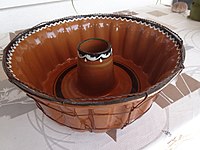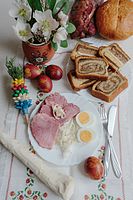
A samosa or singara is a fried or baked pastry with a savory filling, including ingredients such as spiced potatoes, onions, and peas. It may take different forms, including triangular, cone, or half-moon shapes, depending on the region. Samosas are often accompanied by chutney, and have origins in medieval times or earlier. Samosas are a popular entrée, appetizer, or snack in the cuisines of South Asia, the Middle East, Central Asia, East Africa and their diasporas.

Prekmurska gibanica is a type of Slovenian gibanica or layered pastry. It contains poppy seeds, walnuts, apples, raisins and quark fillings. Although native to Prekmurje, it has achieved the status of a national specialty of Slovenia. The unique sweetmeat shows the variety of agriculture in this region. The name gibanica comes from the dialect expression güba and in this case refers to a fold.
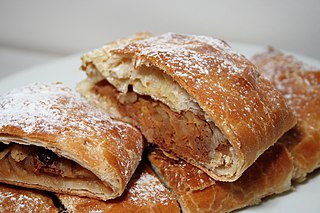
Apple strudel is a traditional Viennese strudel, a popular pastry in Austria, Bavaria, the Czech Republic, Northern Italy, Slovenia, and other countries in Europe that once belonged to the Austro-Hungarian Empire (1867–1918).

A hamantash is an Ashkenazi Jewish triangular filled-pocket pastry, associated with the Jewish holiday of Purim. The name refers to Haman, the villain in the Purim story. In Hebrew, hamantashen are also known as אוזני המן meaning "Haman's ears". "Haman's ears" also refers to a Sephardic Purim pastry, "Orejas de Haman," thought to originate in Spain and Italy, that is made by frying twisted or rolled strips of dough.

Kuih are bite-sized snack or dessert foods commonly found in Southeast Asia and China. It is a fairly broad term which may include items that would be called cakes, cookies, dumplings, pudding, biscuits, or pastries in English and are usually made from rice or glutinous rice. In China, where the term originates from, kueh or koé in the Min Nan languages refers to snacks which are typically made from rice but can occasionally be made from other grains such as wheat. The term kuih is widely used in Malaysia, Brunei, and Singapore, kueh is used in Singapore and Indonesia, kue is used in Indonesia only, all three refer to sweet or savoury desserts.
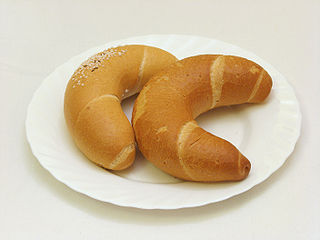
Kifli, kiflice, kifle or kipferl is a traditional yeast bread roll that is rolled and formed into a crescent before baking.

A Swiss roll, jelly roll, roll cake, cream roll, roulade or Swiss log is a type of rolled sponge cake filled with whipped cream, jam, or icing. The origins of the term are unclear; in spite of the name "Swiss roll", the cake is believed to have originated elsewhere in Central Europe, possibly Austria or Slovenia. It appears to have been invented in the nineteenth century, along with Battenberg cake, doughnuts, and Victoria sponge. In the U.S., commercial versions of the cake are sold with the brand names of Ho Hos, Yodels, Swiss Cake Rolls, and others. A type of roll cake called Yule log is traditionally served at Christmas.

Rugelach is a filled baked confection originating in the Jewish communities of Poland. It is popular in Israel, commonly found in most cafes and bakeries. It is also a popular treat among Jews in the diaspora.

Gibanica is a traditional pastry dish popular all over the Balkans. It is usually made with cottage cheese and eggs. Recipes can range from sweet to savoury, and from simple to festive and elaborate multi-layered cakes.
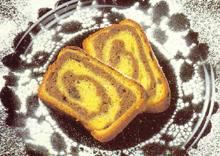
A nut roll is a pastry consisting of a sweet yeast dough that is rolled out very thin, spread with a nut paste made from ground nuts and a sweetener like honey, then rolled up into a log shape. This 'log' is either left long and straight or is often bent into a horseshoe shape, egg washed, baked, and then sliced crosswise. Nut rolls resemble a jelly roll but usually with more layers of dough and filling, and resemble strudels but with fewer and less delicate dough layers. Fillings commonly have as their main ingredient ground walnuts or poppy seeds.

Bourekas or burekas are a popular baked pastry in Sephardic Jewish cuisine and Israeli cuisine. A variation of the burek, a popular pastry throughout southern Europe, northern Africa and the Middle East, Israeli bourekas are made in a wide variety of shapes and a vast selection of fillings, and are typically made with either puff pastry, filo dough, or brik pastry, depending on the origin of the baker.
Tatar cuisine is primarily the cuisine of the Volga Tatars, who live in Tatarstan, Russia, and surrounding areas.

Slovenian cuisine is influenced by the diversity of Slovenia's landscape, climate, history and neighbouring cultures. In 2016, the leading Slovenian ethnologists divided the country into 24 gastronomic regions. The first Slovene-language cookbook was published by Valentin Vodnik in 1798.
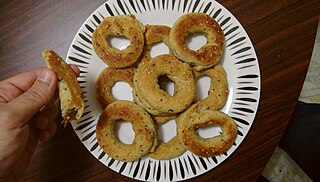
Ka'ak or kahqa is the common Arabic word for biscuit, and can refer to several different types of baked goods produced throughout the Arab world and the Near East. The bread, in Middle Eastern countries, is similar to a dry and hardened biscuit and mostly ring-shaped. Similar pastry, called "kue kaak", is also popular in Indonesia.

The poppy seed roll is a pastry consisting of a roll of sweet yeast bread with a dense, rich, bittersweet filling of poppy seed. An alternative filling is a paste of minced walnuts, or minced chestnuts.

Štruklji are a traditional Slovene dish, composed of dough and various types of filling. The dish comes in the form of rolls, which can be either cooked or baked, and can have a wide range of fillings. Štruklji has been traditionally reserved for special occasions, but is now one of the most characteristic everyday dishes in households all across Slovenia. It is closely related to Zagorski štrukli, a traditional Croatian dish.

A babka is a sweet braided bread or cake which originated in the Jewish communities of Poland and Ukraine. It is popular in Israel and in the Jewish diaspora. It is prepared with a yeast-leavened dough that is rolled out and spread with a filling such as chocolate, cinnamon, fruit, or cheese, then rolled up and braided before baking.
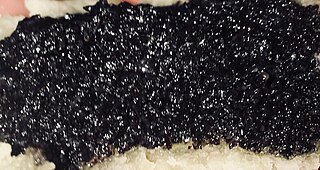
Poppy seed paste, also known as mohn, is a common ingredient in Jewish pastries and desserts. It is made from ground poppy seeds and additional sweeteners. Examples of pastries featuring the filling include mohn kichel, babka, and, most famously, hamantashen. In Jewish cuisine, the filling is traditionally referred to as mohn, the word for poppy in both Yiddish and German. Poppy seed-filled pastries are particularly associated with the holiday of Purim.


